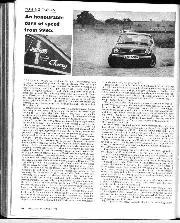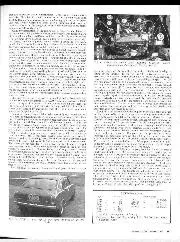

Tuning topics
An honourable turn of speed from 998cc In the May issue we struck our first official acquaintance with Datsun's smallest offering in the UK, the 1-litre Cherry 100A. Although this…
A CUNNING C NVIERSION
How an old G.N. was Powered with a Morris Engine with Excellent Results.
HOWE VER much motorcars may progress and become standardised, there will always be a certain class of enthusiasts who want to build something of their own. I am not thinking at the moment of the idealists who wish to design unique and wonderful vehicles in the style they think will be the fashion twenty years hence, but of the more practical and usually rather hard up motorists who want to have the greatest possible amusement at the least possible cost, and do not mind doing some work to get it.
Such a one was the constructor of the vehicle about to be described. The number of G.N. enthusiasts is still large, in spite of the fairly long time since they were last made, and being one of them, it seemed natural to use a G.N. chassis as the basis of the proposed car, especially as he happened to have one at the time. The power unit was a Morris Cowley engine of fairly ancient vintage, but considerable power, and as the result is still in action a description may be of interest to some of our readers.
The good roadholding and handling of the G.N. chassis and the reliability of the Morris engine are well known, and the pair makes a lively and amusing vehicle, and the fact that the engine bearers are just the correct width for the chassis is a great initial advantage. The first thing to do is to remove
the body complete, and forget it. For the job to be satisfactory a new body is essential. This is not as bad as it sounds. If the engine has been acquired avec gearbox, as is most likely, remove this and forget it too !
As old Cowley engines can often be picked up for a very small sum this should not cause any heartburning. Better still, sell it if you can ! Remove the flywheel (don’t forget this, however), take out the three pins which drive the Morris ‘clutch, and turn the rear flange of the flywheel down flush to give a flat disc. Take the four pins out of the G.N. flywheel and fit them in the Morris flywheel in exactly the same relative positions. Those not in a position to do this work themselves will not find it expensive to get it done locally. The flywheel naturally requires a big lathe to handle it well, but all the other work of this conversion can be managed easily on a 3i inch Drummond. If the engine is the older type it will have a dry
clutch. If later it will have an off feed to the clutch department which must be stopped up. Refit the flywheel and wire the retaining bolts.
The G.N. clutch will now fit straight on to the engine. The fibre brushes which take the drive from the pins will probably require renewing. The fibre blocks used on a Morgan clutch withdrawal do well for this. They are thicker and wear longer. Longer iron rivets will of course, be required. Drop the engine on to the chassis, when all cross shafts, etc., have been removed. In actual practice it is simpler to take the chassis, less front axle, and thread it over the engine ; then lift the lot on to suitable blocks. The sump should be removed, and the engine position settled so that the starting handle boss comes close to the front chassis number. In the centre of this drill a hole large enough for the starting handle shaft. Cut this shaft off to such a length that when the handle is refitted it will clear the track rod. It must be made detachable for sump removal, by means of a set screw or similar device. At least a 5/16 inch bolt, preferably larger, should be used, or starting will shear it. See that
A CUNNING CONVERSION—continued.
the handle is fitted in correct relative position to the compression strokes, or swinging will be difficult. Having settled the position of the engine and centred it in the chassis, the holes can be marked and drilled
inch. The bolts should pass right through the chassis, and through hard wood blocks made a tight fit in the channel. The steering box will now lie between the front an,d rear engine bearers. The column can be raked further by a suitable wedge between the box and chassis. The front axle can then be reapplied to the chassis. Stronger front springs are advisable. This is most cheaply managed by fitting an extra leaf between each of the exist
ing leaves, the length being the mean of the leaves above and below in each case. The resulting seven-leaf spring is adequate for the additional load, but check leaves can be fitted above them if desired.
In any case new U-bolts or plain bolts and straps will be needed. Suitable hard wood or aluminium wedges under front and rear springs will drop the chassis to axle level and improve stability and appearance. The front axle radius arms must be strengthened, either by substituting a tube or channel for the existing flat strip, or by fitting the Hartfords used on present-day Frazer-Nash cars. The latter is the better method, but also the more expensive.
To return to the transmission— the propellor shaft must be shortened. This was done by removing the required amount from the centre of the shaft (which is a tube) and inserting a solid piece which was bolted through with two inch bolts in each section. Many other ways of doing the job will occur to readers, but it was not wished to disturb the ends.
The bush in the front of the propellor shaft must be withdrawn and a solid spigot turned up and fitted in its place. A good pressed-in fit is sufficient. The spigot itself should be a fairly easy fit in the spigot bearing of the Morris engine. The body is the next item, and the one fitted is somewhat unorthodox in design but very effective in results. The
construction of the framework and the final appeaTance can be fairly easily seen from the photographs.
Two ash cross members 4 inches deep and 1 inch thick are fixed by long coach bolts under the chassis ; one bolt just forward of the bevelbox and the other just in rear of the clutch. Their length decides the width of the body which in this case was 2ft. Sins. To the ends of these members were screwed vertical pieces of ash, 1 inch square and 9 ins. long. These carried the main lower frame of the body consisting of two 9 inch by inch deal planks. At the front these fit inside the under shield support, and are cut away to clear the rear axle and meet, boat fashion, in a stern post.
This frame carries all the uprights of the body except the dash itself, which is supported by brackets to the chassis and also by being bolted to the rear of the engine ; and except the seat which is mounted direct on the chassis, and forms the main support for the tail. This is absolutely rigid and will support the weight of as many people as can sit on it. All uprights, longerons, etc., are ash. The whole is covered with
three-ply screwed on with inch steel screws. The result is covered with black fabric tacked on. The cost of the body materials should not exceed about 26 and the results in this case have been quite satisfactory. There are of course man y other details in the con
struction which might be explained, but will be fairly obvious to anyone with a mechanical turn of mind. The controls will, of course, have to be revised considerably and the seating on the finished job will be much further back. If the owner is tall an additional six inches let into the steering column will improve the driving position. Other modifications to the chassis will depend chiefly on the amount of money available, and on the ingenuity of the constructor. The gear ratio will stand raising considerably as the Morris has plenty of power at low speeds, and the whole car is so light that a 3.5 top gear is not too high for a nice cruising speed.
If the G.N. chassis is the old type with spring steel brake shoes, the newer type of cast iron shoes with Ferodo lining should be substituted.
No claim is made that the resulting body is the best design for the chassis, but it can easily be modified, and the method of construction makes it light and strong. The number of conversions possible, with the G.N. chassis as a basis, is very large, and variations of the above theme should be capable of providing the impecunious owner with an interesting vehicle and plenty of practice in the use of workshop equipment. —W.S.B.